-
Tips for becoming a good boxer - November 6, 2020
-
7 expert tips for making your hens night a memorable one - November 6, 2020
-
5 reasons to host your Christmas party on a cruise boat - November 6, 2020
-
What to do when you’re charged with a crime - November 6, 2020
-
Should you get one or multiple dogs? Here’s all you need to know - November 3, 2020
-
A Guide: How to Build Your Very Own Magic Mirror - February 14, 2019
-
Our Top Inspirational Baseball Stars - November 24, 2018
-
Five Tech Tools That Will Help You Turn Your Blog into a Business - November 24, 2018
-
How to Indulge on Vacation without Expanding Your Waist - November 9, 2018
-
5 Strategies for Businesses to Appeal to Today’s Increasingly Mobile-Crazed Customers - November 9, 2018
Virtual Unwrapping Unlocks Secrets Of A Charred Biblical Scroll
“I think we can safely say that since the completion of the publication of the Corpus of Dead Sea Scrolls about a decade ago. the En-Gedi Leviticus Scroll is the most extensive and significant biblical text from antiquity that has come to light”, said co-author Michael Segal of Hebrew University in Jerusalem, who analyzed the text from the resulting digital images.
Advertisement
In addition to the decipherment of a heavily charred ancient Hebrew scroll, it is also confirms the first time a Torah scroll was ever found in a synagogue inside a Holy Ark in an archaeological excavation.
A rare piece of burnt parchment from En-Gedi.
It is also so fragile that it disintegrates every time it’s touched. “We never dreamt we could bring it back to life”. The parchment, known to be part of the Ein Gedi scrolls discovered in 1970, likely burned in a fire that destroyed a synagogue in the year 600 AD, Foxnews.com noted. Inside the ancient synagogue’s ark, archaeologists found lumps of scroll fragments.
In a study published September 21 in Science Advances, Seales and co-authors describe the process and present their findings.
The study was led by Brent Seales, a professor and chairman of the department of computer science at the University of Kentucky who has been working with technology and damaged materials for two decades. This time, the researchers were able to recover almost all of the ancient writing, with the exception of a few areas where the parchment had burned away completely.
First, the team scanned the scroll using micro-computed tomography-a commercially available machine often used for cancer imaging. The software pipeline, referred to as “virtual unwrapping”.
The process starts with a scan that reveals the internal structure and contents of an object, like the one the Israel Antiquities Authority made when it decided, on its own, to make the micro-CT scan.
The software is created to first detect the individual pages based on their expected geometry, then “texture” it, or look for changes in brightness on the surfaces identified as pages. Part of the solution to this problem was to look at small segments of the scroll at a time, the authors said.
They weren’t expecting to find actual, readable text, but they did.
Dense areas – ones covered in ink, for example – appear brighter on the scan.
But they weren’t done yet.
They first could see that the scroll contained writing when they examined the digital version of the document in the lab, which made them feel “elated”, Seales said in a response to a question during the news conference. Finally, they virtually “unrolled” the scroll to reveal the writing inside. The computer then flattens the regions out and merges them into one complete image.
However, their new research using high resolution scanning and virtual unwrapping has allowed the team to recover substantial ink-based text at high quality.
“This is quite fantastic for us”, he said. “The scan we sent him looked like charcoal”.
Crumbling pages may soon be no match for modern technology: Earlier this month, scientists at the Massachusetts Institute of Technology announced a new imaging method that allows them to virtually pierce the first few pages of delicate books and analyse their text.
The scroll is not the oldest ever found – that honor belongs to the biblical Dead Sea Scrolls which range from the third century BC to the second century of the common era (AD).
“We were immediately struck by the fact that in these passages, the En-Gedi Leviticus scroll is identical in all of its details both regarding its letter and section division to what we call the Masoretic text, the authoritative Jewish text until today”. This is of great interest to Biblical scholars, as it pushes back the date of their seminal text and shows that the version of the Hebrew bible in use today had been standardized by at least the fourth century. Could it work on burnt scrolls? It’s actually the first time virtual mapping was used.
An explanation of the technique used to “unwrap” the scroll. “I’m sure that security and intelligence constantly is looking for ways to extract better information noninvasively from materials”, he said.
Advertisement
“I believe there are more discoveries to come”, Seales said.




























